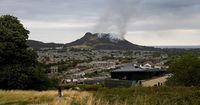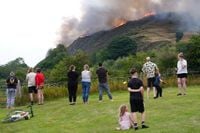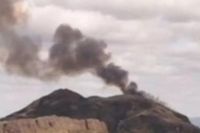On the evening of August 10, 2025, a dramatic scene unfolded atop one of Edinburgh’s most iconic landmarks. Arthur’s Seat, the extinct volcano rising above the Scottish capital, became the site of a large gorse fire that sent plumes of black smoke billowing across the city’s skyline. The blaze, which broke out just after 4 p.m., quickly spread across the steep hillsides of Holyrood Park, drawing a swift and robust response from Scotland’s emergency services.
According to reports from BBC and The Record, the Scottish Fire and Rescue Service (SFRS) mobilized four fire appliances and specialist resources within minutes of the alarm. As Group Commander Niall MacLennan explained, “We were alerted at 4:05 p.m. on Sunday, 10 August, to reports of a fire in the open at Arthur’s Seat, Edinburgh. Operations Control mobilised four fire appliances and specialist resources to a fire affecting a large area of gorse.” Firefighters battled the flames overnight and into the next day, with crews working tirelessly to dampen down hotspots and prevent the fire from reigniting.
Thankfully, there were no reports of casualties. The area was evacuated promptly as the flames advanced, and the public was advised to steer clear of the south side of Arthur’s Seat while firefighting operations continued. The SFRS maintained a visible presence, with two to three fire appliances remaining on site into Monday, August 11, 2025, as confirmed by both BBC and The Independent.
The fire’s timing was particularly challenging for the city. Edinburgh was bustling with activity, as the world-renowned Edinburgh Festival Fringe—the largest performance arts festival globally—had just kicked off. Meanwhile, crowds had gathered for a series of sold-out Oasis concerts at Murrayfield Stadium. The influx of tourists and festival-goers only heightened the urgency to control the fire and secure the area.
Eyewitnesses recounted the fire’s rapid escalation. Nick Brice, a visitor from Brighton, told BBC Scotland News, “We could see this little plume of smoke on the ridge at the far side, and it just got bigger and bigger. All of a sudden we could see these flames starting to come up and people noticed it spreading fast.” Local resident Nim Byron described the experience as “pretty scary,” adding, “It shows how dry it has actually been in Scotland this summer, this is not normal, as Scotland is famously a very wet place.”
As the fire raged, thick smoke was visible from much of the city and beyond. The dramatic sight was a stark reminder of the destructive power of wildfires, particularly in a year when Scotland has experienced an unusually dry and warm summer. In fact, as The Independent reported, Scotland had its driest spring since 1964, with a daily water deficit of 60 million litres during droughts. This prolonged dryness left vegetation, especially dead growth from previous years, highly susceptible to ignition.
Experts and officials were quick to address the likely cause of the blaze. While the exact ignition source remains under investigation, Group Commander MacLennan stated unequivocally, “While we have no indication of the cause of the fire, the majority of fires of this nature are started by human behaviour. Responsible human behaviour can significantly lower the chance of a fire starting. It’s vital to follow all safety advice when outdoors and to make sure you are familiar with the Scottish Outdoor Access Code at all times.” He reiterated to BBC Radio, “We don’t have specifics… but what we can pretty much be certain of is it would have been some form of human behaviour or intervention of some sort. It’s very rare for any natural wildfires to start in this country.”
The fire’s impact extended beyond the immediate danger to people and property. City of Edinburgh council leader Jane Meagher highlighted the environmental toll, telling BBC, “The fire at Arthur’s Seat is a sharp reminder of wildfire’s destructive power, and the speed at which it can cause significant damage. I’m grateful that no one was hurt, however it has had a devastating effect on local wildlife whose habitats have been damaged or destroyed.”
Dr. Rory Hadden, a senior lecturer in fire investigation at the University of Edinburgh, provided further context. Speaking to The Independent and BBC, he explained, “Wildfires in and around Arthur’s Seat in Edinburgh occur relatively often. Like this one, these typically burn relatively small areas (compared to other wildfires in Scotland) but can have relatively large impacts due to the location and proximity to people—the plume of smoke can exacerbate respiratory conditions as well as the direct danger to those on the hill. It has been very dry in Edinburgh this year. This means that vegetation—particularly dead growth from previous years—is very dry. The weather in Edinburgh has been reasonably good recently (sunny and warm) but with quite strong winds. This all acts to dry out even more of the dead vegetation, making it easy to ignite—and once ignited, for the fire to spread rapidly. Especially on the steep terrain of Arthur’s Seat.”
Indeed, the combination of dry weather, strong winds, and human activity has proven a dangerous mix. Professor Rory Hadden also noted that wildfires in Scotland are becoming “larger, more common and more difficult to put out” due to climate change and evolving land use patterns, such as increased rewilding and rural depopulation. The SFRS had already issued several wildfire warnings earlier in the summer, following major blazes in the Highlands that were described as the largest in Scotland’s history.
Historic Environment Scotland, which manages Holyrood Park, responded by closing the High Road and adjacent pavement until at least Friday, August 15, 2025, to support ongoing emergency work. A spokesperson urged visitors to “continue to follow guidance from the emergency services and avoid the south side of Arthur’s Seat while the Scottish Fire and Rescue Service continue their work.” Road closures and area restrictions were implemented overnight, with gradual reopening as conditions allowed.
Arthur’s Seat, standing 822 feet above sea level, is a beloved destination for locals and tourists alike, offering panoramic views of Edinburgh’s Old Town and the North Sea. Its popularity, especially during festival season, underscores the importance of fire safety and environmental stewardship in such heavily visited natural spaces.
This incident was not without precedent. A similar fire struck Arthur’s Seat in 2019, requiring eight hours of firefighting to bring under control. The recurrence of such events is a sobering sign of changing environmental conditions and the ongoing challenge of managing human impact on fragile landscapes.
As the smoke dissipates and Edinburgh returns to its festive summer rhythm, the Arthur’s Seat fire of August 2025 stands as a vivid reminder: even in places famed for their greenery and rain, vigilance and responsible behavior are essential to protecting the natural treasures that define a city’s character.


